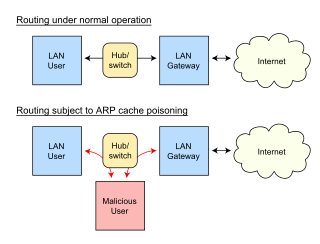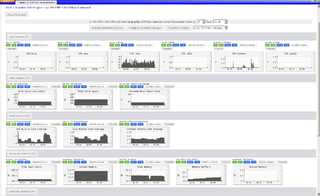| Original author(s) | Craig Leres |
|---|---|
| Developer(s) | Lawrence Berkeley National Laboratory Network Research Group |
| Initial release | v1.0 Tue Jun 16 3:05:31 PDT 1992 |
| Stable release | 3.2 / December 15, 2021 |
| Written in | C |
| Operating system | Cross-platform |
| Available in | English |
| Type | Computer security |
| License | 3-clause BSD source with autoconf parts under GNU General Public License |
| Website | ee |
arpwatch is a computer software tool for monitoring Address Resolution Protocol traffic on a computer network. [1] It generates a log of observed pairing of IP addresses with MAC addresses along with a timestamp when the pairing appeared on the network. It also has the option of sending an email to an administrator when a pairing changes or is added.
Network administrators monitor ARP activity to detect ARP spoofing, network flip-flops, changed and new stations and address reuse.
arpwatch was developed by Lawrence Berkeley National Laboratory, Network Research Group, as open-source software and is released under the BSD license.
The Address Resolution Protocol (ARP) is a communication protocol used for discovering the link layer address, such as a MAC address, associated with a given internet layer address, typically an IPv4 address. This mapping is a critical function in the Internet protocol suite. ARP was defined in 1982 by RFC 826, which is Internet Standard STD 37.

In computer terminology, a honeypot is a computer security mechanism set to detect, deflect, or, in some manner, counteract attempts at unauthorized use of information systems. Generally, a honeypot consists of data that appears to be a legitimate part of the site and contain information or resources of value to attackers. It is actually isolated, monitored, and capable of blocking or analyzing the attackers. This is similar to police sting operations, colloquially known as "baiting" a suspect.
Zero-configuration networking (zeroconf) is a set of technologies that automatically creates a usable computer network based on the Internet Protocol Suite (TCP/IP) when computers or network peripherals are interconnected. It does not require manual operator intervention or special configuration servers. Without zeroconf, a network administrator must set up network services, such as Dynamic Host Configuration Protocol (DHCP) and Domain Name System (DNS), or configure each computer's network settings manually.

CUPS is a modular printing system for Unix-like computer operating systems which allows a computer to act as a print server. A computer running CUPS is a host that can accept print jobs from client computers, process them, and send them to the appropriate printer.

In computer networking, ARP spoofing, ARP cache poisoning, or ARP poison routing, is a technique by which an attacker sends (spoofed) Address Resolution Protocol (ARP) messages onto a local area network. Generally, the aim is to associate the attacker's MAC address with the IP address of another host, such as the default gateway, causing any traffic meant for that IP address to be sent to the attacker instead.

Network security consists of the policies, processes and practices adopted to prevent, detect and monitor unauthorized access, misuse, modification, or denial of a computer network and network-accessible resources. Network security involves the authorization of access to data in a network, which is controlled by the network administrator. Users choose or are assigned an ID and password or other authenticating information that allows them access to information and programs within their authority. Network security covers a variety of computer networks, both public and private, that are used in everyday jobs: conducting transactions and communications among businesses, government agencies and individuals. Networks can be private, such as within a company, and others which might be open to public access. Network security is involved in organizations, enterprises, and other types of institutions. It does as its title explains: it secures the network, as well as protecting and overseeing operations being done. The most common and simple way of protecting a network resource is by assigning it a unique name and a corresponding password.

A host-based intrusion detection system (HIDS) is an intrusion detection system that is capable of monitoring and analyzing the internals of a computing system as well as the network packets on its network interfaces, similar to the way a network-based intrusion detection system (NIDS) operates. This was the first type of intrusion detection software to have been designed, with the original target system being the mainframe computer where outside interaction was infrequent.
The Intelligent Platform Management Interface (IPMI) is a set of computer interface specifications for an autonomous computer subsystem that provides management and monitoring capabilities independently of the host system's CPU, firmware and operating system. IPMI defines a set of interfaces used by system administrators for out-of-band management of computer systems and monitoring of their operation. For example, IPMI provides a way to manage a computer that may be powered off or otherwise unresponsive by using a network connection to the hardware rather than to an operating system or login shell. Another use case may be installing a custom operating system remotely. Without IPMI, installing a custom operating system may require an administrator to be physically present near the computer, insert a DVD or a USB flash drive containing the OS installer and complete the installation process using a monitor and a keyboard. Using IPMI, an administrator can mount an ISO image, simulate an installer DVD, and perform the installation remotely.

Ettercap is a free and open source network security tool for man-in-the-middle attacks on LAN. It can be used for computer network protocol analysis and security auditing. It runs on various Unix-like operating systems including Linux, Mac OS X, BSD and Solaris, and on Microsoft Windows. It is capable of intercepting traffic on a network segment, capturing passwords, and conducting active eavesdropping against a number of common protocols. Its original developers later founded Hacking Team.

Ganglia is a scalable, distributed monitoring tool for high-performance computing systems, clusters and networks. The software is used to view either live or recorded statistics covering metrics such as CPU load averages or network utilization for many nodes.

A computer network is a set of computers sharing resources located on or provided by network nodes. The computers use common communication protocols over digital interconnections to communicate with each other. These interconnections are made up of telecommunication network technologies, based on physically wired, optical, and wireless radio-frequency methods that may be arranged in a variety of network topologies.

OSSIM is an open source security information and event management system, integrating a selection of tools designed to aid network administrators in computer security, intrusion detection and prevention.
Honeyd is an open source computer program created by Niels Provos that allows a user to set up and run multiple virtual hosts on a computer network. These virtual hosts can be configured to mimic several different types of servers, allowing the user to simulate an infinite number of computer network configurations. Honeyd is primarily used in the field of computer security.
The Neighbor Discovery Protocol Monitor (NDPMon) is a diagnostic software application used by network administrators for monitoring ICMPv6 packets in Internet Protocol version 6 (IPv6) networks. NDPMon observes the local network for anomalies in the function of nodes using Neighbor Discovery Protocol (NDP) messages, especially during the Stateless Address Autoconfiguration. When an NDP message is flagged, it notifies the administrator by writing to the syslog or by sending an email report. It may also execute a user-defined script. For IPv6, NDPMon is an equivalent of Arpwatch for IPv4, and has similar basic features with added attacks detection.

Network Security Toolkit (NST) is a Linux-based Live DVD/USB Flash Drive that provides a set of free and open-source computer security and networking tools to perform routine security and networking diagnostic and monitoring tasks. The distribution can be used as a network security analysis, validation and monitoring tool on servers hosting virtual machines. The majority of tools published in the article "Top 125 security tools" by Insecure.org are available in the toolkit. NST has package management capabilities similar to Fedora and maintains its own repository of additional packages.
Eucalyptus is a paid and open-source computer software for building Amazon Web Services (AWS)-compatible private and hybrid cloud computing environments, originally developed by the company Eucalyptus Systems. Eucalyptus is an acronym for Elastic Utility Computing Architecture for Linking Your Programs To Useful Systems. Eucalyptus enables pooling compute, storage, and network resources that can be dynamically scaled up or down as application workloads change. Mårten Mickos was the CEO of Eucalyptus. In September 2014, Eucalyptus was acquired by Hewlett-Packard and then maintained by DXC Technology. After DXC stopped developing the product in late 2017, AppScale Systems forked the code and started supporting Eucalyptus customers.
Apple's Bonjour Sleep Proxy service is an open source component of zero-configuration networking, designed to assist in reducing power consumption of networked electronic devices.

Performance Co-Pilot is an open source software infrastructure for monitoring, visualizing, recording, responding to, and controlling the status, activity, and performance of networks, computers, applications, and servers.

ArpON is a computer software project to improve network security. It has attracted interest among network managers and academic researchers and is frequently cited as a means of protecting against ARP-based attacks.
RTP-MIDI is a protocol to transport MIDI messages within RTP packets over Ethernet and WiFi networks. It is completely open and free, and is compatible both with LAN and WAN application fields. Compared to MIDI 1.0, RTP-MIDI includes new features like session management, device synchronization and detection of lost packets, with automatic regeneration of lost data. RTP-MIDI is compatible with real-time applications, and supports sample-accurate synchronization for each MIDI message.